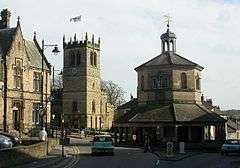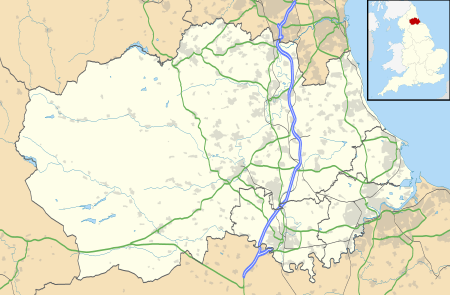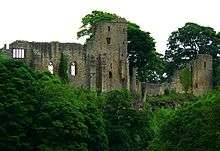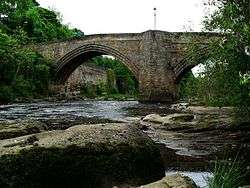Barnard Castle
Barnard Castle (locally [ˈbɑːnəd ˈkæsəl], BAH-nəd KASS-əl) is a market town in Teesdale, County Durham, England. It is named after the castle around which it was built. It is the main settlement in the Teesdale area, and a popular tourist destination. The Bowes Museum has what is considered to be the best collection of European fine and decorative arts in the North of England, housed in a 19th-century French-style chateau.[3] Its most famous exhibit is the 18th-century Silver Swan automaton, and its artworks include paintings by Goya and El Greco.
| Barnard Castle | |
|---|---|
 Part of Barnard Castle Market Place showing the "Market Cross" or "Butter Market" | |
 Barnard Castle Location within County Durham | |
| Population | 5,495 (2011)[1] |
| OS grid reference | NZ047166 |
| Civil parish |
|
| Unitary authority | |
| Ceremonial county | |
| Region | |
| Country | England |
| Sovereign state | United Kingdom |
| Post town | BARNARD CASTLE |
| Postcode district | DL12 |
| Dialling code | 01833 |
| Police | Durham |
| Fire | County Durham and Darlington |
| Ambulance | North East |
| UK Parliament | |
Barnard Castle sits on the north bank of the River Tees, opposite Startforth and 21 miles (34 km) south-west of the county town of Durham. Nearby towns include Bishop Auckland to the north-east, Darlington to the east and Richmond in North Yorkshire to the south-east.
Barnard Castle's largest single employer is GlaxoSmithKline, which has a manufacturing facility on the town outskirts.[4][5][6]
History
Before the Norman conquest the upper half of Teesdale had been combined into an Anglo-Norse estate which was centred upon the ancient village of Gainford and mortgaged to the Earls of Northumberland. The first Norman Bishop of Durham, Bishop Walcher, was murdered in 1080. This led to the surrounding country being attacked and laid waste by the Norman overlords. Further rebellion in 1095 caused the king William II to break up the Earldom of Northumberland into smaller baronies. The Lordship of Gainford was given to Guy de Balliol.
The earthwork fortifications of the castle were rebuilt in stone by his successor, Bernard de Balliol I during the latter half of the 12th century, giving rise to the town's name.[7] The castle passed down through the Balliol family (of which the Scottish king, John Balliol, was the most important member) and then into the possession of Richard Neville, Earl of Warwick. King Richard III inherited it through his wife, Anne Neville, but it fell into ruins in the century after his death.
The remains of the castle are a Grade I listed building, whilst the chapel in the outer ward is Grade II* listed.[8] Both sets of remains are now in the care of English Heritage and open to the public.
John Bowes lived at nearby Streatlam Castle (now demolished). His Streatlam stud never had more than ten breeding mares at one time, but produced no fewer than four Derby winners in twenty years. The last of these, "West Australian", was the first racehorse to win the Triple Crown, in 1853.
Bowes and his wife Joséphine Benoîte Coffin-Chevallier founded the Bowes Museum, which is of national status. Housed in its own ornate building, the museum contains an El Greco, paintings by Goya, Canaletto, Boucher, Fragonard and a collection of decorative art. A great attraction is the 18th century silver swan automaton, which periodically preens itself, looks round and appears to catch and swallow a fish.
Although never a major manufacturing centre, in the 18th century industry centred on hand loom wool weaving, and in the early 19th century the principal industry was spinning and the manufacture of shoe thread.[9]
Notable visitors

Walter Scott frequently visited his friend John Sawrey Morritt at Rokeby Hall and was fond of exploring Teesdale. He begins his epic poem Rokeby (1813) with a man standing on guard on the round tower of the Barnard Castle fortress.[10]
Charles Dickens and his illustrator Hablot Browne (Phiz) stayed at the King's Head in Barnard Castle while researching his novel Nicholas Nickleby in the winter of 1837–38. He is said to have entered William Humphrey's clock-maker's shop, then opposite the hotel, and enquired who had made a certain remarkable clock. William replied that his boy Humphrey had done it. This seems to have prompted Dickens to choose the title "Master Humphrey's Clock" for his new weekly, in which The Old Curiosity Shop and Barnaby Rudge appeared.[11][12][13]
William Wordsworth,[14] Daniel Defoe,[15] Ralph Waldo Emerson,[16] Hilaire Belloc,[17] Bill Bryson[18] and the artist J. M. W. Turner[19] have also visited the town.
In May 2020, Barnard Castle came to national attention when the chief advisor of the British Prime Minister, Dominic Cummings, was discovered to have driven to the town with his family during the COVID-19 pandemic. Following media allegations that he had broken lockdown regulations by driving to the town, he told how he drove there to test his eyesight to reassure his wife that he was able to drive them back to London the next day.[20][21][22]
Governance

Barnard Castle is for all purposes (historic, ceremonial and administrative) located in County Durham.
The county boundary with the North Riding of Yorkshire was adjusted in 1967: that part of the town of Barnard Castle historically in Yorkshire was added to County Durham.[23]
Barnard Castle was the administrative centre of the former Teesdale district of County Durham until its abolition on 1 April 2009. The town is now administered by Durham County Council Unitary Authority, as principal authority and by Barnard Castle Town Council, as a parish. The Town Council elects a ceremonial Town Mayor annually. It is part of the Bishop Auckland parliamentary constituency, which as of 2019 is represented in parliament by Dehenna Davison of The Conservative Party. It is in the North East England region, which serves as a constituency for the European Parliament.[24] Between 1894 and 1967 the town was administratively part of Barnard Castle Urban District.[25]
All four Durham County Councillors whose wards (Barnard Castle East and Barnard Castle West) include part of Barnard Castle are Conservative.[26]
The local police force is Durham Constabulary. The town is the base for the Barnard Castle division, which covers 300 square miles (780 km2). This division is within the force's south area.
Geography
- Elevation: 180 m (600 ft)
- Nearest large towns: Darlington, 16 miles (26 km). Bishop Auckland 14.8 miles
Economy
The most important employer in Barnard Castle is Glaxo Smithkline, which has a large pharmaceutical manufacturing plant on the outskirts of the town which employs around 1000 people.[27] GSK has invested £80 million into the plant since 2007.[28]
Transport
Barnard Castle has road connections to Bishop Auckland, Spennymoor and central County Durham via the A688 and Darlington, Stockton-on-Tees, and Middlesbrough by the A67. Barnard Castle is also four miles (6.4 km) from the A66, with access to the M6 to the west and the A1(M) to the east. The B6278 also connects Barnard Castle with Middleton-in-Teesdale.
Barnard Castle railway station was closed for passenger trains in 1964. A Bill was approved in 1854 for a line from a junction with the Stockton & Darlington Railway at Darlington to Barnard Castle and opened on 9 July 1856, with intermediate stations at Broomielaw, Winston, Gainford and Piercebridge. The terminus at Darlington only lasted five years. In 1856 the South Durham & Lancashire Railway proposed a line from Bishop Auckland to Tebay via Barnard Castle and Kirkby Stephen but only the western section was built with the Company receiving its Bill in 1857.
The line opened on 8 August 1861 from a second terminus at Barnard Castle to a junction with the Lancaster & Carlisle Railway at Tebay with intermediate stations at Lartington, Bowes, Barras, Kirkby Stephen, Ravenstondale & Gaisgill. The two stations at Barnard Castle were some distance apart; the earliest station became a through station and closed to passengers on 1 May 1862, but remained in use as a goods depot. The second station was closed for passenger trains under the Beeching cuts in 1964 and completely on 5 April 1965 and the site was eventually built on by GlaxoSmithKline.[29] Today rail access is via Bishop Auckland, 15 miles (25 km) or Darlington, 16 miles (26 km). There are two bus routes provided by Arriva North East which connect Barnard Castle to Darlington, the X75 and X76.
Education
Barnard Castle School

Barnard Castle School, an independent co-educational boarding school located on the eastern edge of the town.
Teesdale School
Teesdale School is an 11–18 comprehensive school on the outskirts of the town, just off the A688.
Green Lane School
Green Lane school is a primary school for 4–11 year olds, situated on a road of the same name not far from Teesdale School.
St Mary's RCVA Primary school
St Mary's is a Roman Catholic school situated on Birch Road near the church of the same name.
Culture
The town hosts the Bowes Museum,[30] purpose-built as a public gallery to house the collection of John and Josephine Bowes. It is regarded as one of the finest museums in the north of England, being in the style of a French chateau, in extensive grounds, and is by far the largest building in the town. It contains paintings by El Greco, Francisco Goya, Canaletto, Jean-Honoré Fragonard and François Boucher, together with a sizable collection of decorative art, ceramics, textiles, tapestries, clocks and costumes, as well as older items from local history. It is most famous for the Silver Swan automaton, which plays every day at 2pm.
The Witham Arts Centre[31] on the Horse Market, holds a wide variety of events including drama, cinema, music, spoken word and children's events as well as being the town's visitor information point.
The TCR Hub[32] is a community centre on the edge of the town with a wide range of indoor and outdoor activities for young people and families and for the community more generally.
An annual live music festival, organised by Teesdale Community Resources in conjunction with the Barnard Castle Meet Committee, runs over the Whit weekend alongside the many other 'Meet' activities. It is a three-day event with out-of-town bands playing on the Saturday and local bands & up and coming TCR bands playing on the Sunday and Monday. It is a family friendly event and entrance is totally free.
The Barnard Castle Meet is an annual carnival festival held on the second bank holiday weekend in May, the schools' summer half-term week. The Meet, as it is known locally, has grown from the North East Cyclists' Meet dating back to 1885, and since the early 1900s the town has staged a carnival and grand procession through the town centre on the bank holiday Monday. The weekend is now probably the largest event in the Barnard Castle and Teesdale calendar. There are around twenty separate events that the Meet Committee asserts 'reach every corner of the community'. In recent years, with the R 'n' B festival no longer in the Meet Weekend programme, the Committee has staged its own music event showcasing local and national talent on the Sunday and Monday, with all technical and musical support from Teesdale Community Resources (TCR).
The Barnard Castle Band, founded in 1860, is a brass band based in the town, well known outside the area as a result of the march Barnard Castle by Goff Richards.[33]
Notable people
- Anne Fine – children's writer. Twice Whitbread Prize winner.
- Arthur Henderson - Winner of Nobel Peace prize (1934). Former MP for Barnard Castle and first Labour cabinet minister[34]
- Glenn Hugill – TV presenter and producer
- David Jennings – composer
- Ian Usher – traveller, adventurer, writer and speaker. Sold "entire life" on eBay in 2008
Former residents
- Joshua Harold Burn, FRS 1942, Emeritus Professor of Pharmacology at Oxford University
- Bob Chatt, footballer for Aston Villa
- Siobhan Fahey, singer/songwriter from Bananarama/Shakespears Sister lived here for a short time as a child
- Hannah Hauxwell, English farmer who was the subject of several television documentaries
- William Hutchinson, 18th-century historian[35]
- Roderick Murchison, President of both the Royal Geological and the Royal Geographical Societies
- Cyril Northcote Parkinson, writer and inventor
- Henry Witham, geologist and philanthropist
References
- "Town population 2011". Archived from the original on 14 July 2015. Retrieved 6 July 2015.
- http://www.barnardcastletowncouncil.gov.uk/
- Daily Mail (London) 10 January 2009 Saturday 1ST Edition BRIC-A-BRAC BRITAIN; NORMAN MILLER goes on a rummage to find the top ten towns for bargain hunters
- "GSK Barnard Castle". Devereux Architects. Archived from the original on 3 May 2014.
- "BBC – Domesday Reloaded: A BARNARD CASTLE FACTORY". domesday.
- "Teesdale Mercury". teesdalemercury.co.uk. Archived from the original on 3 May 2014.
- Lilley, Charles (2000). Old Barnard Castle. Catrine, Ayrshire: Stenlake Publishing. p. 3. ISBN 9781840331059.
- Historic England. "Monument No. 19875". PastScape. Retrieved 6 October 2015.
- All in due time: the collected essays and broadcast talks of Humphry House By Humphry House p283
- "History of Barnard Castle, in Teesdale and County Durham – Map and description". visionofbritain.org.uk.
- "BBC News – Exhibition explores Charles Dickens' links with County Durham". BBC News.
- Jordan, John O.; John, Jordan O. (18 June 2001). The Cambridge Companion to Charles Dickens. google.co.uk. ISBN 9780521669641.
- "Barnard Castle Blue Plaque Trail". teesdalediscovery.com. Archived from the original on 16 July 2014.
- "Places Visited and Letters Written: 1798–1800". wordsworth.org.uk.
- "Vision of Britain – Daniel Defoe – Letter 8, Part 4: Leeds and North Yorkshire". visionofbritain.org.uk.
- "XI. English Traits. Aristocracy. Emerson, Ralph Waldo. 1909–14. Essays and English Traits. The Harvard Classics". bartleby.com.
- Belloc, Hilaire. "On getting respected in inns and hotels". quotidiana.org.
- Dickinson, Katie (25 September 2016). "How kind will Bill Bryson be on the North East?". nechronicle.
- "Barnard Castle: The Castle and Bridge looking Upstream, Joseph Mallord William Turner – Tate". Tate.
- "A site for sore eyes? How Dominic Cummings put Barnard Castle on the map". The Guardian. 26 May 2020. ISSN 0261-3077. Retrieved 27 May 2020.
- "No 10 'chaos' as 'defiant' PM defends Cummings". BBC News. UK: BBC. 25 May 2020. Retrieved 27 May 2020.
- Keating, Joshua (26 May 2020). "Why Is the U.K. in an Uproar Over a Boris Johnson Adviser's COVID Road Trip?". Slate Magazine. Retrieved 27 May 2020.
- Vision of Britain – Yorkshire, North Riding Archived 29 April 2011 at the Wayback Machine. Retrieved 30 November 2007.
- "Barnard Castle Town Council". barnardcastletowncouncil.gov.uk.
- "National Archive record for Barnard Castle Urban District Council". The National Archives. Retrieved 19 January 2015.
- "Your Councillors". Durham County Council. Retrieved 16 September 2019.
- "Barnard Castle". GlaxoSmithKline. Archived from the original on 8 June 2011. Retrieved 2011-05-22.
- "Glaxo expansion meeting held". The Advertiser Series. Archived from the original on 24 July 2011. Also here
- "Disused Stations – Barnard Castle". Disused Railway Stations. Retrieved 8 September 2015.
- "The Bowes Museum > Home". www.thebowesmuseum.org.uk.
- "The Witham". thewitham.org.uk.
- "County Durham Venue | Parties & Events| Businesses| Schools". TCR Hub.
- "Barnard Castle Band". Archived from the original on 22 December 2010. Retrieved 2010-01-26.
- "Arthur Henderson: a Labour pioneer". Northern Echo. 3 April 2013. Retrieved 22 June 2020.
- Fraser, C. M. "Hutchinson, William". Oxford Dictionary of National Biography (online ed.). Oxford University Press. doi:10.1093/ref:odnb/14291. (Subscription or UK public library membership required.)
External links
- Barnard Castle Tourist Website
- Photos and information on Barnard Castle
- . Encyclopædia Britannica. 3 (11th ed.). 1911.
| Wikimedia Commons has media related to Barnard Castle. |